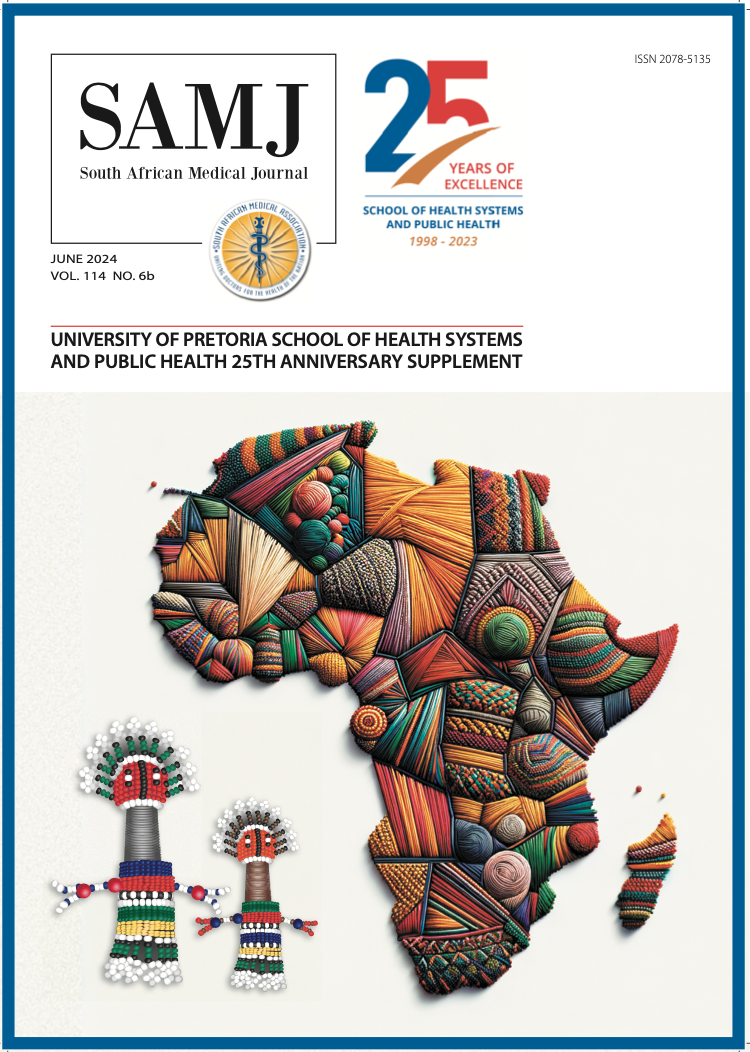HIV status and contraceptive use in Zimbabwe among sexually active adolescent girls and women: Secondary analysis of Zimbabwe Demographic Health survey data
DOI:
https://doi.org/10.7196/SAMJ.2024.v114i16b.1407Keywords:
Contraception, HIV, Zimbabwe, National SurveyAbstract
Background. Understanding the pattern of contraceptive use among women living with HIV is critical for formulating relevant public health interventions to improve the uptake and use of reliable methods in this population. This helps to reduce the incidence of unintended pregnancies.
Objective. In this secondary data analysis, we aimed to describe contraceptive use by HIV-positive and HIV-negative sexually active adolescent girls and women, using data from the Zimbabwe Demographic and Health Survey (2015-16).
Method. We used statistical analysis to determine the association between the use of various methods of contraception and HIV status using the Zimbabwe Demographic and Health Survey, 2015-16 data.
Results. Overall, the contraceptive use prevalence in this study was 60%. Sexually active adolescent girls and women on the Pill and injections were less likely to be HIV-positive compared with those not using any method of contraception (odds ratio (OR)=0.54, 95% confidence interval (CI) (0.45 - 0.64), p=0.001; and OR=0.75, 95% CI (0.59 - 0.96), p=0.020, respectively). Those using either a male or female condom were more likely to be HIV-positive, OR=3.36, 95% CI (2.63 - 4.28), p=0.001.
Conclusions. This study revealed that there is still a considerable unmet need for contraception among the study population, highlighting the need to devise strategies to increase contraception uptake among women. Statistically significant differences were noted in the use of condoms, with those who are HIV-positive having a higher use of condoms compared with those who are HIV-negative. This may reflect that HIV-positive individuals have received appropriate counselling messages on the need to use barrier methods.
References
Ministry of Health and Child Care (MoHCC). Zimbabwe Population-based HIV Impact Assessment (ZIMPHIA 2020): Final Report. https://phia.icap.columbia.edu/zimbabwe2020-final-report/ (accessed 11 January 2024).
Zimbabwe National Family Planning Strategy (ZNFPS). http://www.znfpc.org.zw/wp-content/ uploads/2019/05/ZFPS-Final.pdf (accessed 8 March 2021).
Malunguza NJ, Hove-Musekwa SD, Mukandavire Z. Assessing the potential impact of hormonal-based contraceptives on HIV transmission dynamics among heterosexuals. Bull Math Biol 2017;79(4):738- 771. https://doi.org/10.1007/s11538-017-0252-y
Ralph LJ, McCoy SI, Shiu K, Padian NS. Hormonal contraceptive use and women’s risk of HIV acquisition: A meta-analysis of observational studies. Lancet Infect Dis 2015;15(2):181-189. https:// doi.org/10.1016/S1473-3099(14)71052-7
Prata N, Sreenivas A, Bellows B. Potential of dual-use policies to meet family planning and HIV prevention needs: A case study of Zimbabwe and Mozambique. J Fam Plann Reprod Health Care 2008;34(4):219-226. https://doi.org/10.1783/147118908786000406
Wilcher R, Petruney T, Reynolds H, Cates W. From effectiveness to impact: Contraception as an HIV prevention intervention. Sex Transm Infect 2008;84(Suppl 2):ii54-ii60. https://doi.org/10.1136/ sti.2008.030098
Zimbabwe National Family Planning Council. Methods of family planning. http://www.znfpc.org.zw/ methods-of-family-planning/ (accessed 8 March 2021).
World Health Organization. WHO issues statements on the use of reversible hormonal contraception.
https://www.who.int/reproductivehealth/topics/family_planning/statements-reversible-hc/en/
(accessed 8 March 2021).
Katz IT, Maughan-Brown B. Improved life expectancy of people living with HIV: Who is left behind? Lancet HIV 2017;4(8):e324-e326. https://doi.org/10.1016/S2352-3018(17)30086-3
Ford N, Calmy A, Mills EJ. The first decade of antiretroviral therapy in Africa. Globalisation Health 2011;7(1):1-6. https://doi.org/10.1186/1744-8603-7-33
Erhabor O, Adias T, Akani C. Reproductive health challenges of living with HIV-infection in sub- Saharan Africa. Curr Perspect HIV Infect 2013:325. https://doi.org/10.5772/52682
United Nations General Assembly. Transforming Our World: the 2030 agenda for Sustainable Development Goals. 2015. https://sdgs.un.org/2030agenda (accessed 8 March 2021).
United Nations Population Fund. In the midst of the COVID-19 pandemic UNFPA and partners call for greater efforts to ensure access to contraceptives for women and girls. https://zimbabwe.unfpa. org/en/news/midst-covid-19-pandemic-unfpa-and-partners-call-greater-efforts-ensure-access- contraceptives (accessed 8 March 2021).
Womack JA, Novick G, Goulet JL. Hormonal contraceptive use in HIV-infected women using antiretroviral therapy: A systematic review. J Contraception 2015;6:37. https://doi.org/10.2147/ OAJC.S55038
Martino RJ, Chirenda J, Mujuru HA, Ye W, Yang Z. Characteristics indicative of tuberculosis/HIV coinfection in a high-burden setting: Lessons from 13,802 incident tuberculosis cases in Harare, Zimbabwe. Am J Trop Med Hygiene 2020;103(1):214-220. https://doi.org/10.4269/ajtmh.19-0856
Sutton MY, Zhou W, Frazier EL. Unplanned pregnancies and contraceptive use among HIV-positive women in care. PloS ONE 2018;13(5):e0197216. https://doi.org/10.1371/journal.pone.0197216
Adeniyi OV, Ajayi AI, Moyaki MG, ter Goon D, Avramovic G, Lambert J. High rate of unplanned pregnancy in the context of integrated family planning and HIV care services in South Africa. BMC Health Serv Res 2018;18(1):1-8. https://doi.org/10.1186/s12913-018-2942-z
Tibaijuka L, Odongo R, Welikhe E, et al.Factors influencing use of long-acting versus short-acting contraceptive methods among reproductive-age women in a resource-limited setting. BMC Women’s Health 2017;17(1):1-13. https://doi.org/10.1186/s12905-017-0382-2
Joshi R, Khadilkar S, Patel M. Global trends in use of long-acting reversible and permanent methods of contraception: Seeking a balance. Int J Gynecol Obstet 2015;131:S60-S63. https://doi.org/10.1016/j. ijgo.2015.04.024
Politi MC, Estlund A, Milne A, Buckel CM, Peipert JF, Madden T. Barriers and facilitators to implementing a patient-centered model of contraceptive provision in community health centers. Contraception Reprod Med 2016;1(1):1-9. https://doi.org/10.1186/s40834-016-0032-3
Downloads
Published
Issue
Section
License
Copyright (c) 2024 G Musuka, G Murewanhema, Z Mukandavire, I Chingombe, D Cuadros, F Mutenherwa, T Dzinamarira, R Eghtessadi, N Malunguza, M Mapingure

This work is licensed under a Creative Commons Attribution-NonCommercial 4.0 International License.
Licensing Information
The SAMJ is published under an Attribution-Non Commercial International Creative Commons Attribution (CC-BY-NC 4.0) License. Under this license, authors agree to make articles available to users, without permission or fees, for any lawful, non-commercial purpose. Users may read, copy, or re-use published content as long as the author and original place of publication are properly cited.
Exceptions to this license model is allowed for UKRI and research funded by organisations requiring that research be published open-access without embargo, under a CC-BY licence. As per the journals archiving policy, authors are permitted to self-archive the author-accepted manuscript (AAM) in a repository.
Publishing Rights
Authors grant the Publisher the exclusive right to publish, display, reproduce and/or distribute the Work in print and electronic format and in any medium known or hereafter developed, including for commercial use. The Author also agrees that the Publisher may retain in print or electronic format more than one copy of the Work for the purpose of preservation, security and back-up.





